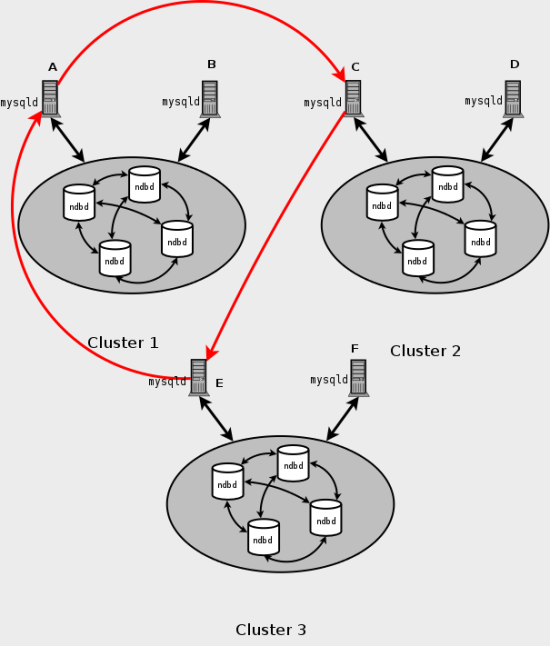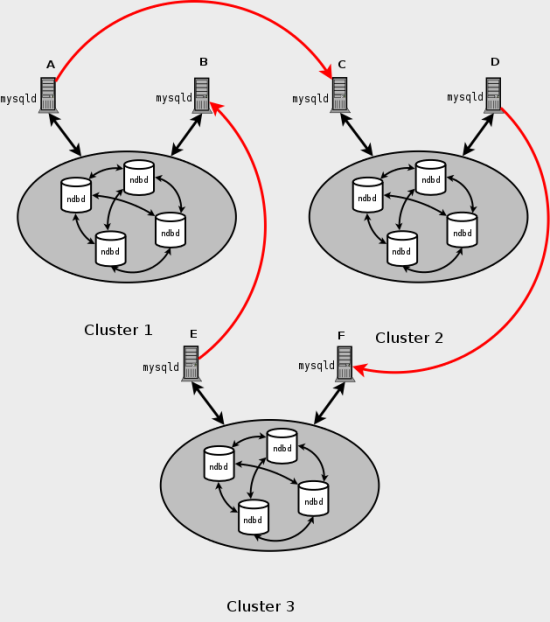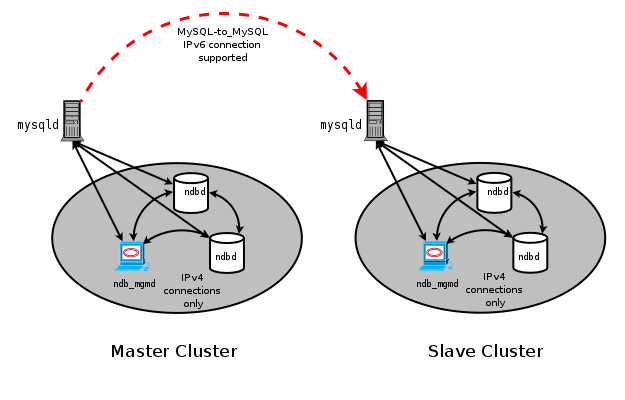

|
Spec-Zone .ru
спецификации, руководства, описания, API
|
This section discusses known problems or issues when using replication with MySQL Cluster NDB 7.3.
Loss of master-slave connection. A loss of connection can
occur either between the replication master SQL node and the replication slave SQL node, or between the
replication master SQL node and the data nodes in the master cluster. In the latter case, this can occur not
only as a result of loss of physical connection (for example, a broken network cable), but due to the overflow
of data node event buffers; if the SQL node is too slow to respond, it may be dropped by the cluster (this is
controllable to some degree by adjusting the MaxBufferedEpochs and TimeBetweenEpochs configuration parameters). If this occurs, it is entirely possible for new data to be inserted into the master cluster without
being recorded in the replication master's binary log. For this reason, to guarantee high
availability, it is extremely important to maintain a backup replication channel, to monitor the primary
channel, and to fail over to the secondary replication channel when necessary to keep the slave cluster
synchronized with the master. MySQL Cluster is not designed to perform such monitoring on its own; for this, an
external application is required.
The replication
master issues a "gap" event when connecting or
reconnecting to the master cluster. (A gap event is a type of "incident event,"
which indicates an incident that occurs that affects the contents of the database but that cannot easily be
represented as a set of changes. Examples of incidents are server crashes, database resynchronization, (some)
software updates, and (some) hardware changes.) When the slave encounters a gap in the replication log, it stops
with an error message. This message is available in the output of SHOW SLAVE STATUS, and indicates that the SQL thread has stopped due to an
incident registered in the replication stream, and that manual intervention is required. See Section
17.6.8, "Implementing Failover with MySQL Cluster Replication", for more information about what to do in
such circumstances.
Because MySQL Cluster is not designed on its own to monitor replication status or provide failover, if high availability is a requirement for the slave server or cluster, then you must set up multiple replication lines, monitor the master mysqld on the primary replication line, and be prepared fail over to a secondary line if and as necessary. This must be done manually, or possibly by means of a third-party application. For information about implementing this type of setup, see Section 17.6.7, "Using Two Replication Channels for MySQL Cluster Replication", and Section 17.6.8, "Implementing Failover with MySQL Cluster Replication".
However, if you are replicating from a standalone MySQL server to a MySQL Cluster, one channel is usually sufficient.
Circular replication. MySQL Cluster Replication supports circular replication, as shown in the next example. The replication setup involves three MySQL Clusters numbered 1, 2, and 3, in which Cluster 1 acts as the replication master for Cluster 2, Cluster 2 acts as the master for Cluster 3, and Cluster 3 acts as the master for Cluster 1, thus completing the circle. Each MySQL Cluster has two SQL nodes, with SQL nodes A and B belonging to Cluster 1, SQL nodes C and D belonging to Cluster 2, and SQL nodes E and F belonging to Cluster 3.
Circular replication using these clusters is supported as long as the following conditions are met:
The SQL nodes on all masters and slaves are the same
All SQL nodes acting as replication masters and slaves are started using the --log-slave-updates
option
This type of circular replication setup is shown in the following diagram:

In this scenario, SQL node A in Cluster 1 replicates to SQL node C in Cluster 2; SQL node C replicates to SQL node E in Cluster 3; SQL node E replicates to SQL node A. In other words, the replication line (indicated by the red arrows in the diagram) directly connects all SQL nodes used as replication masters and slaves.
It should also be possible to set up circular replication in which not all master SQL nodes are also slaves, as shown here:

In this case, different SQL nodes in each cluster are used as replication masters and slaves. However, you must
not start any of the SQL nodes using --log-slave-updates. This type of circular replication scheme for MySQL
Cluster, in which the line of replication (again indicated by the red arrows in the diagram) is discontinuous,
should be possible, but it should be noted that it has not yet been thoroughly tested and must therefore still
be considered experimental.
The NDB storage engine uses idempotent execution mode,
which suppresses duplicate-key and other errors that otherwise break circular replication of MySQL Cluster.
This is equivalent to setting the global slave_exec_mode system variable to IDEMPOTENT. This is also required for multi-master replication when using
MySQL Cluster. (Bug #31609)
It is not necessary to set slave_exec_mode in MySQL Cluster replication; MySQL Cluster does this
automatically for all NDB
tables and ignores any attempts to set this variable explicitly.
MySQL Cluster replication and primary keys. In the event of
a node failure, errors in replication of NDB tables without primary keys can still occur, due to the possibility of
duplicate rows being inserted in such cases. For this reason, it is highly recommended that all NDB tables being replicated have primary keys.
MySQL Cluster Replication and Unique Keys. In older
versions of MySQL Cluster, operations that updated values of unique key columns of NDB tables could result in duplicate-key errors when replicated. This issue
is solved for replication between NDB
tables by deferring unique key checks until after all table row updates have been performed.
Deferring constraints in this way is currently supported only by NDB. Thus, updates of unique keys when replicating from NDB to a different storage engine such as MyISAM or InnoDB are still not supported.
The problem encountered when replicating without deferred checking of unique key updates can be illustrated
using NDB
table such as t, is created and populated on the master (and replicated to a slave
that does not support deferred unique key updates) as shown here:
CREATE TABLE t ( p INT PRIMARY KEY, c INT, UNIQUE KEY u (c)) ENGINE NDB;INSERT INTO t VALUES (1,1), (2,2), (3,3), (4,4), (5,5);
The following UPDATE statement on t succeeded on the master, since
the rows affected are processed in the order determined by the ORDER BY option,
performed over the entire table:
UPDATE t SET c = c - 1 ORDER BY p;
However, the same statement failed with a duplicate key error or other constraint violation on the slave, because the ordering of the row updates was done for one partition at a time, rather than for the table as a whole.
Every NDB table is implicitly partitioned by key when it is created. See Section 18.2.5,
"KEY Partitioning", for more information.
Restarting with --initial.
Restarting the cluster with the --initial option causes the sequence of GCI and epoch numbers to start over
from 0. (This is generally true of MySQL Cluster and not limited to replication
scenarios involving Cluster.) The MySQL servers involved in replication should in this case be restarted. After
this, you should use the RESET MASTER
and RESET SLAVE statements to clear the invalid ndb_binlog_index
and ndb_apply_status tables, respectively.
Replication from NDB to
other storage engines. It is possible to replicate an NDB table on the master to a table using a different storage engine on the slave,
taking into account the restrictions listed here:
Multi-master and circular replication are not supported (tables on both the master
and the slave must use the NDB
storage engine for this to work).
Using a storage engine does not perform binary logging for slave tables requires special handling.
Use of a nontransactional storage engine for slave tables also requires special handling.
The next few paragraphs provide additional information about each of the issues just described.
Multiple masters not supported when replicating NDB to other storage engines.
For replication from NDB to a different storage engine, the relationship between the two databases
must be a simple master-slave one. This means that circular or master-master replication is not supported
between MySQL Cluster and other storage engines.
In addition, it is not possible to configure more than one replication channel when replicating between NDB and a different storage engine. (However, a MySQL Cluster database can simultaneously replicate to multiple slave MySQL Cluster databases.) If
the master uses NDB tables, it is still possible to have more than one MySQL Server maintain
a binary log of all changes; however, for the slave to change masters (fail over), the new master-slave
relationship must be explicitly defined on the slave.
Replicating NDB to a slave storage engine that does not perform binary logging.
If you attempt to replicate from a MySQL Cluster to a slave that
uses a storage engine that does not handle its own binary logging, the replication process aborts with the error
Binary logging not possible ... Statement cannot be written atomically since more than one engine involved and at least one engine is self-logging
(Error 1595). It is possible to work around this issue in one of the following
ways:
Turn off binary logging on the slave. This can be accomplished by setting sql_log_bin
= 0.
Change the storage engine used for the mysql.ndb_apply_status
table. Causing this table to use an engine that does not handle its own binary logging can also
eliminate the conflict. This can be done by issuing a statement such as ALTER TABLE mysql.ndb_apply_status ENGINE=MyISAM on the slave. It is
safe to do this when using a non-NDB storage engine on the slave, since you do not then need to worry
about keeping multiple slave SQL nodes synchronized.
Filter out changes to the mysql.ndb_apply_status
table on the slave. This can be done by starting the slave SQL node with --replicate-ignore-table=mysql.ndb_apply_status. If you need for other
tables to be ignored by replication, you might wish to use an appropriate --replicate-wild-ignore-table option instead.
You should not disable replication or binary logging of
mysql.ndb_apply_status or change the storage engine used for this table when
replicating from one MySQL Cluster to another. See Replication
and binary log filtering rules with replication between MySQL Clusters, for details.
Replication from NDB to a nontransactional storage engine. When replicating from NDB to a nontransactional storage engine such as MyISAM, you may encounter unnecessary duplicate key errors when replicating INSERT ... ON DUPLICATE
KEY UPDATE statements. You can suppress these by using --ndb-log-update-as-write=0, which forces updates to be logged as writes (rather
than as updates).
In addition, when replicating from NDB
to a storage engine that does not implement transactions, if the slave fails to apply any row changes from a
given transaction, it does not roll back the rest of the transaction. (This is true when replicating tables
using any transactional storage engine—not only NDB—to a nontransactional storage engine.) Because of this, it cannot be
guaranteed that transactional consistency will be maintained on the slave in such cases.
Replication and binary log filtering rules with
replication between MySQL Clusters. If you are using any of the options --replicate-do-*,
--replicate-ignore-*, --binlog-do-db, or --binlog-ignore-db to filter databases or tables being replicated, care must
be taken not to block replication or binary logging of the mysql.ndb_apply_status,
which is required for replication between MySQL Clusters to operate properly. In particular, you must keep in
mind the following:
Using --replicate-do-db= (and
no other db_name--replicate-do-* or --replicate-ignore-* options) means that only tables in database db_name are replicated. In this case, you should also use
--replicate-do-db=mysql,
--binlog-do-db=mysql,
or --replicate-do-table=mysql.ndb_apply_status
to ensure that mysql.ndb_apply_status is populated on slaves.
Using --binlog-do-db= (and no other db_name--binlog-do-db options) means that changes only
to tables in database db_name are written to the binary
log. In this case, you should also use --replicate-do-db=mysql, --binlog-do-db=mysql, or --replicate-do-table=mysql.ndb_apply_status to ensure that mysql.ndb_apply_status is populated on slaves.
Using --replicate-ignore-db=mysql means that no tables in the mysql database are replicated. In this case, you should also use --replicate-do-table=mysql.ndb_apply_status
to ensure that mysql.ndb_apply_status is replicated.
Using --binlog-ignore-db=mysql
means that no changes to tables in the mysql database are written to
the binary log. In this case, you should also use --replicate-do-table=mysql.ndb_apply_status to ensure that mysql.ndb_apply_status is replicated.
You should also remember that each replication rule requires the following:
Its own --replicate-do-* or --replicate-ignore-*
option, and that multiple rules cannot be expressed in a single replication filtering option. For
information about these rules, see Section
16.1.4, "Replication and Binary Logging Options and Variables".
Its own --binlog-do-db or --binlog-ignore-db option, and that multiple rules cannot be expressed in
a single binary log filtering option. For information about these rules, see Section
5.2.4, "The Binary Log".
If you are replicating a MySQL Cluster to a slave that uses a storage engine other than NDB, the considerations just given previously may not apply, as discussed
elsewhere in this section.
MySQL Cluster Replication and IPv6. Currently, the NDB API and MGM API do not support IPv6. However, MySQL Servers—including those acting as SQL nodes in a MySQL Cluster—can use IPv6 to contact other MySQL Servers. This means that you can replicate between MySQL Clusters using IPv6 to connect the master and slave SQL nodes as shown by the dotted arrow in the following diagram:

However, all connections originating within the MySQL Cluster—represented in the preceding diagram by solid arrows—must use IPv4. In other words, all MySQL Cluster data nodes, management servers, and management clients must be accessible from one another using IPv4. In addition, SQL nodes must use IPv4 to communicate with the cluster.
Since there is currently no support in the NDB and MGM APIs for IPv6, any applications written using these APIs must also make all connections using IPv4.
Attribute promotion and demotion. MySQL Cluster Replication includes support for attribute promotion and
demotion. The implementation of the latter distinguishes between lossy and non-lossy type conversions, and their
use on the slave can be controlled by setting the slave_type_conversions global server system variable.
For more information about attribute promotion and demotion in MySQL Cluster, see Row-based replication: attribute promotion and demotion.